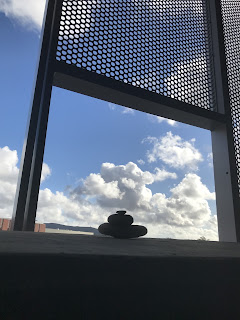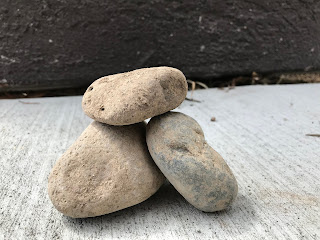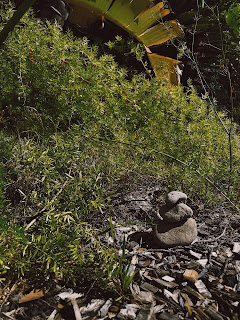“Who you looking for?”
I turned from the door I had just knocked on. Parked at the
curb in front of the house was a pickup truck, and sitting in the passenger
seat was a young African-American guy. I told him the name of the woman that
was on my sheet.
“She’s at work.”
“You know if she’s planning to vote?”
“Nah, I don’t think so.”
I left a couple of doorhangers on the knob and walked toward
the truck. “How about you,” I asked. “Are you going to vote?”
“Nah.”
“Why not?”
“Don’t seem to change much.”
This was not a conversation I imagined for myself when I decided
to volunteer this election season. This conversation was, in fact, the furthest
thing from my mind.
But let me back up.
Sometime early in 2018, I told myself that I was going to do
something more for the midterm elections than just vote and fume at the news on my
phone or TV. I wanted to contribute—money, time, whatever—instead of sit on the
sidelines and maybe wonder on the morning of November 7th if I could
have done more. So in September I came across a group via Twitter—“Flip the 49th
– Neighbors in Action,” which was mobilizing efforts to turn my congressional
district from red to blue by getting Mike Levin more votes than his republican
opponent.
The people there were amazing. Lots of energy, and not just
from the young men and women who did the bulk of the organizing, but also from
the rank-and-file workers, many of whom were retired and spending the
equivalent of a full-time job in the office, on the phones, or on the streets
knocking on doors. It was a broad-based coalition that included various area
union members as well as a passionate group of suburban women who were members
of “Moms Demand Action,” a group committed to stronger gun control laws. At
every turn, I was inspired by the spirit of activism and the dedication to
devote one’s time and energy toward positive change.
Still, though, I had a few simple rules. I would do whatever
they needed, but I would NOT make phone calls and I would NOT knock on doors. Need
voter IDs to enter? Say no more. Need something moved? I’m your guy. But
interacting with strangers—about an election, of all things, and in a nuclear
environment, no less—was not something I was going to do. No how, no way.
Perhaps you can see where this is going.
In the face of the raw energy and enthusiasm of these
people, my stupid rules didn’t stand a chance. And I’m glad they didn’t.
On my second day volunteering, our organizer, a young woman
named Elizabeth, asked if I would call a few people to try out the new phone
system. There were others willing to do this, so I passed.
On my third day volunteering, she asked if I would call a
few people to let them know about an upcoming canvass. Fuck it, I thought. “Sure.”
I left about twenty phone messages until I got a real live
person. She was excited, totally on board, but had recently moved to Florida. I
asked if she was voting for Gillum and Nelson, and she said, “You better
believe it.”
The next real-live person I got told me that she had been
writing postcards for Katie Porter (who at this writing was just declared the
winner in the California 45th race) and making calls for some
Democrat Senate candidates around the country.
The conversations continued, and the people I spoke with
were either doing other things—sometimes A LOT of other things—with various
elections or wanted to do more. Nobody yelled at me. Nobody hung up on me.
The next step was canvassing—knocking on doors. Okay, I thought. I’ll give this a try, but I’m going with someone who’ll do all the
talking. So, at my first canvass, I teamed up with a guy named David, who
had done this before. And after a few doors and conversations, I thought, I can do this. So I did.
Let me say this about knocking on doors. The first few are
the hardest. That is, the first few people you actually talk to are the hardest. The fact is that you knock on
many, many doors with no response. But eventually you get a door where someone
answers. My early conversations were awkward, to say the least. I started
from a place where I felt that I was imposing on them, wasting their time,
selling them subscriptions to a magazine or some equally lame product.
But the thing is, that feeling came mostly from me. Like the
phones, nobody yelled, nobody slammed the door in my face. Their demeanor noticeably
changed when I identified myself as a volunteer. I guess when you meet someone
who’s using his or her weekend time to knock on doors, the least you could do
is listen. What powered me through was the simple fact of what was happening:
two citizens having a conversation about our democracy. The campaign’s plan was
to target low-propensity voters, and the reason for this wasn’t simply to get people to vote for
Mike Levin in this election; it was to get people to vote (hopefully for
progressive candidates) in all future elections. It was about welcoming people into the democratic process, about letting them know that they had a voice
and showing them how to use it.
And then suddenly it was election weekend. So what did I do?
Sign up for four straight days of canvassing, of course.
All told, from Saturday to Tuesday, I walked over twenty-five miles, knocked on
probably close to a thousand doors, and had over a hundred conversations with
people. Not only did it not suck, it was actually fun. A few highlights:
A young woman who thought she was in some kind of trouble, but was visibly relieved and then pleasantly shocked to find out that I was just there to make sure she was going to vote.
A mom and daughter who saw Flip the 49th’s coordinated freeway sign drops, were impressed by the fun everyone seemed to be having, looked up Levin’s positions when they got home, and had already voted for him by the time I knocked on their door the night before the election.
A mom and daughter who saw Flip the 49th’s coordinated freeway sign drops, were impressed by the fun everyone seemed to be having, looked up Levin’s positions when they got home, and had already voted for him by the time I knocked on their door the night before the election.
A Spanish-speaking grandmother who wasn’t planning to vote
with just a couple of hours left before the polls closed. My canvassing
partner, Sandi, and I implored her to vote, especially since her polling place
was just around the corner. Her daughter appeared at the door and translated
for us, joining our call to get out and vote. Sandi—a grandmother herself—told
her that she was knocking on doors so that her grandkids had an environment to
enjoy. We watched as the daughter and her mother went back and forth, and even
though I don’t speak Spanish, I could tell that her resolve was softening as
her hand came to her chin and she said “Donde esta something something.” Her daughter smiled at us and said, “I think
she’s going to do it.”
Not every encounter was great. One house had a Levin sign
propped up against it, half-hidden behind a bush. The woman on my list wasn’t
there; her boyfriend or husband answered instead. When I gestured to the sign
and said, “Well, it looks like you’re Levin supporters,” he replied, “She
didn’t have my permission to put that up.” After a couple seconds of telling
myself how not to reply, I just said,
“Well, have a nice day,” while sending his girlfriend or wife powerful psychic
messages to tell him what he could do with his “permission” and dump his
knuckle-dragging ass.
And then there was the young man in his truck who said that
he didn’t vote because it “don’t seem to change much.”
I recalled my training from the day before, about how this
was Get Out The Vote (GOTV) weekend and we had a lot of doors to knock on, so
the last thing we wanted to do was waste time in pointless conversation. The
objective was simple: confirm support for Levin and then help the person make a
voting plan. Anything else was time lost, and we needed to just move on.
I thought about all of that and promptly ignored it. My role
as canvasser was pretty new to me and stood no chance against my over
twenty-five year role as a teacher. I wasn’t about to just move on.
So I explained a little bit about voting. Not about how you
register or absentee ballots or where and when you do it, but about voting. About how that simple action was
anything but simple for many people for most of the history of this nation.
About how men and women, white and black, young and old, were cursed, spat
upon, beaten, and even killed so that every citizen of legal age
could cast a vote. About how not voting disrespects that long history of
sacrifice and struggle. And about how many of the people in power are thrilled
beyond belief that he—this young man sitting in his truck—doesn’t vote. In fact, they count on it.
He nodded thoughtfully, and I’m not fool enough to believe
this was much more than him being polite to some privileged, crazy old white
guy. I asked him his name, told him mine, shook his hand, and said that I hoped
he would reconsider his position on voting. As I walked to the next door, to the next
potential voter, I thought of Jack Nicholson’s line in One Flew over the Cuckoo’s Nest after he fails to lift an
impossibly heavy marble fixture and hurl it through the window so that he and
the other inmates can go find a bar and watch the World Series: “But I tried,
didn’t I? Goddammit, at least I did that much.”
All in all, my experiences guarantee that this wasn't simply a 2018 Midterms thing for me. I'm in for the duration, for as long as we have elections. Democracy is a funny thing. We speak of it in very
high-minded and abstract language, taking its endurance for granted. But it
doesn’t just exist. It needs a lot of care and attention, and it’s one of those
things that if it’s neglected, it will die—a lot more quickly than you would think.
And on the surface, maybe the position that voting doesn’t “seem to change
much” sounds true, but it’s not. The greater truth is that while the Wheels of
Change turn slowly—sometimes excruciatingly so—they do turn. But not unless we
put our hands on them.
























































































